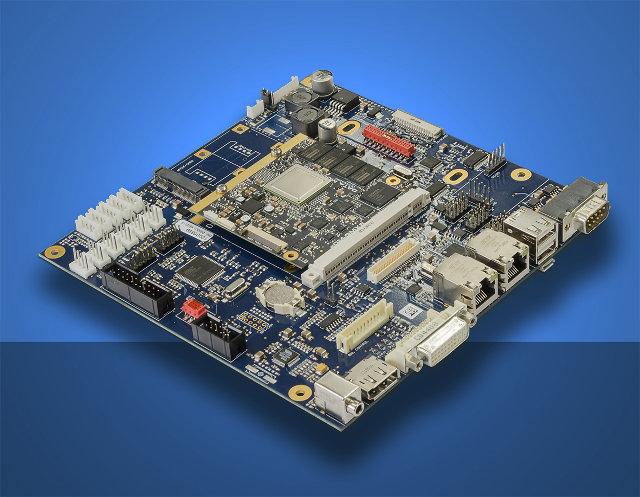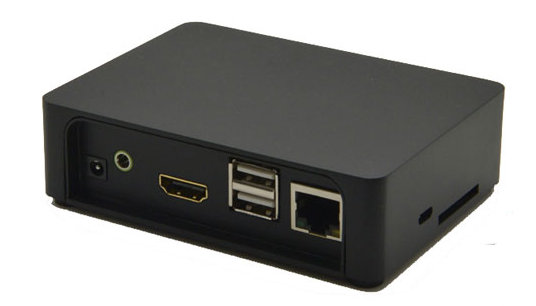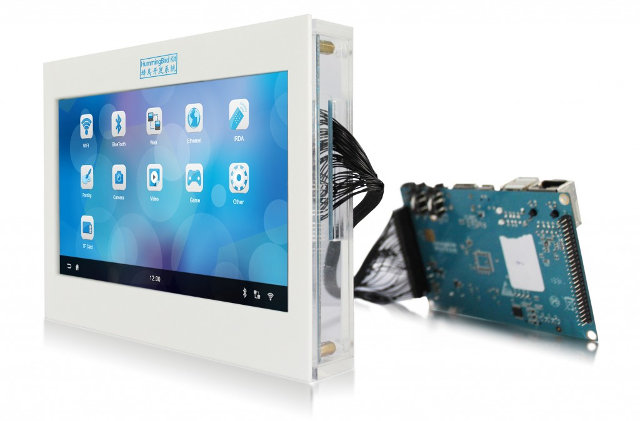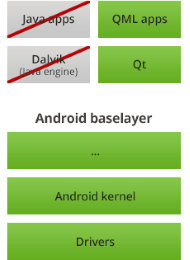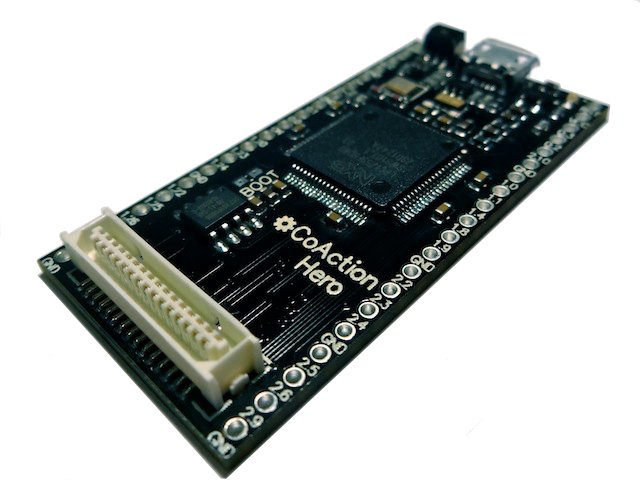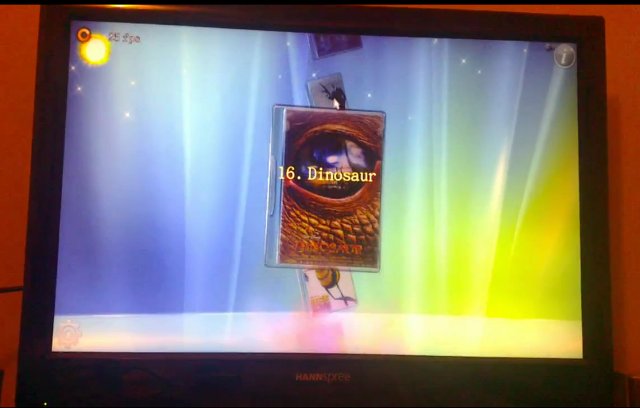DATA MODUL, a specialist supplier of display technology, has recently unveiled eDM-mITX-CB-Q7-Info, a mini-ITX Baseboard for ARM & x86 Qseven modules optimized to drive large panels for digital signage applications. In theory, the board should support any Qseven modules, but for now only Data Modul’s Freescale i.MX6, and Congatec conga-QA3 Intel Atom E3800 series modules have been optimized and officially certified to work with the motherboard. Precisely, the board is optimized and certified for the following modules: DATA MODUL ARM Qseven SoMs: eDM-QMX6 (i.MX6Quad) eDM-DMX6 (i.MX6Dual) eDM-DLMX6 (i.MX6Dual lite) Congatec x86 Qseven SoMs: Conga-QA3 with Atom E3845 (Quad core) Conga-QA3 with Atom E382x (Dual core). Three models: Atom E3827, E3826 or E3825. Conga-QA3 with Atom E3815 (Single core) You may have heard about EDM, a competing module standard, previously, but the eDM prefix in the ARM modules or the mini-ITX board names has nothing to do with this standard, as […]
$69.95 NanoPC-T1 by FriendlyARM Features Samsung Exynos 4412 SoC
If you like low cost boards by Hardkernel such as ODROID-U3, but the add-ons required, and/or shipping costs put you off, an alternative will soon be available thanks to FriendlyARM NanoPC-T1, a tiny computer designed and manufactured by CoreWind Tech FriendlyARM Guangzhou, and powered by Samsung Exynos 4412 quad core Cortex A9 SoC with 1GB RAM, and 4GB built-in flash. FriendlyARM NanoPC specifications: SoC – Samsung Exynos 4412 quad core Cortex-A9 @ 1.5GHz + Mali-400MP4 GPU System Memory – 1GB DDR3 RAM, 32bit data bus Storage – 4GB eMMC Flash + SD Card slot Connectivity – 10/100M Ethernet (RJ45) Video Output – HDMI Audio – 3.5mm Audio Out jack USB – 1x micro USB OTG, 2x USB 2.0 host ports Expansions and I/Os: UART – 4 x TTL UART LCD – TFT LCD interface, support Capacitive/Resistive touch driver 2x Digital sensor input CMOS CAMERA Interface MIPI interface – Support HD […]
Merrii Hummingbird Development Kit Features AllWinner A20 Processor, and an Optional 7″ Touchscreen Display
And yet another AllWinner A20 development platform shows up in my news stream in about 24 hours. Merrii Technology, a Shenzhen based electronics design house, has showed off their Hummingbird Development Kit to ARMDevices.net. The development board comes with 1GB RAM, 4GB NAND Flash, Gigabit Ethernet, SATA, HDMI output, and more. There’s also an optional 7″ capacitive touch screen display for the board. The company explains the kit can be used to develop application such as media players, game consoles, IPTV, automotive products (GPS & IVI), robots, servers, surveillance products, and home automation systems. Here are the board specifications: SoC – AllWinner A20 dual ARM Cortex-A7 core @ 1 GHz with ARM Mali400-MP2 GPU System Memory – 1GB DDR3 (2x 4Gb 16bits DDR3) Storage – 4GB MLC 64bit ECC NAND Flash (Hynix H27UBG8T2A), SATA II connectors, and micro SD card slot (Up to 32GB) Connectivity – Wifi & Bluetooth (two-in-one […]
LinuxCon Europe 2013 Schedule – Web Technologies, Debugging Techniques, Wayland, and More
I’ve just received an email from the Linux Foundation saying the schedule for LinuxCon and CloudOpen Europe 2013 had been made available. The conference will take place for 3 days (October 21-23, 2013) in the Edinburgh International Conference Center, Edinburgh, United Kingdom. There will be over 100 conference sessions, and several co-located events including: Automotive Linux Summit, the Embedded Linux Conference, Gluster Workshop, KVM Forum, Tizen Summit, Xen Project Developer Summit. As I’ve recently done with LinuxCon North America 2013 and ARM TechCon 2013, I’ll make a virtual schedule with selected developer sessions using the event’s schedule builder. You may find out several sessions will also be given in LinuxCon North America. Monday – 21st of October 11:00 – 11:50 – Bluetooth Smart Devices and Low Energy Support on Linux by João Paulo Rechi Vita, INdT This presentation will cover a brief introduction on how the Bluetooth Low Energy technology […]
Digia Brings Qt to Embedded Android Devices with Boot to Qt
Digia has recently announced Boot to Qt Technology Preview, a commercial offering that provides a solution for the creation of user interfaces on embedded systems. For the first version, they stripped out Android of Java, or other unnecessary parts (Zygote, SurfaceFlinger), added Qt/QML, and tested it on on ARM and x86 hardware. Boot to Qt includes the following main features: A light-weight UI stack for embedded Linux, based on the Qt Framework – Boot to Qt is built on an Android kernel/baselayer and offers an elegant means of developing beautiful and performant embedded devices. Ready-made images – We have images for several different devices which include the Boot to Qt software stack, making it possible to get up and running with minimal effort from day one. Full Qt Creator Integration – One-click deploy and run on hardware and a fully featured development environment. Simulator – A VirtualBox based simulator which allows device development […]
CoAction Hero – Low Cost ARM Cortex-M3 Board Running Open Source CoActionOS RTOS
CoAction Hero is a tiny board based on an ARM Cortex-M3 micro-controller (NXP LPC1759), that makes use of CoActionOS ecosystem that includes the hardware, but also an open source RTOS allowing multiple app to run concurrently, and a graphical interface to communicate with the board. First, let’s have a look at the hardware specs: Micro-controller – NXP LPC1759 ARM Cortex-M3 processor @ 120MHz with 64kB RAM and 512kB Flash ROM. Storage – 1MB serial flash chip (pre-loaded with CoActionOS) Expansion port micro USB connector. 40 I/O pins are available on both sides of the board, and the board can be inserted in a breadboard. You can currently connect 2 modules to the board: Bluetooth and LCD device boards. CoActionOS RTOS will come pre-loaded on the board, and if you don’t want to, you don’t even need to know it’s there, and it’s use will be transparent. But let’s have a […]
Booting Linux in Less Than 1 Second in AllWinner A10 Devices? Yes! You Can!
threewater, a Chinese developer, has just posted a very interesting demo on linux-sunxi mailing list showing a device based on AllWinner A10 boot linux within 0.85s, and if you add a Qt app, the total time is just about 1.2s. This appears to be a custom hardware (EM6000), but we do know it’s based on AllWinner A10, comes with 512 MB RAM, and 4GB NAND Flash. On the software side, the device runs kernel 3.4 from linux-sunxi, with a customized version of uboot, a squashfs rootfs, and a Qt 4.7.4 app showing a gauge. Both the rootfs (7MB) and the kernel (2MB) have been compressed with LZO. All that boots from NAND flash for optimal speed. The 1.2 second time includes kernel + rootfs + app time, and the total time is a bit longer, but this is still impressive. Here’s the boot log:
|
1 2 3 4 5 6 7 8 9 10 |
[1.690000 1.690000] U-Boot SPL 2013.01-05984-g2120a27-dirty (Apr 17 2013 - 14:22:02) [0.009000 0.009000] Board: EM6000 [0.012000 0.003000] DRAM: 512MB [1.014000 1.002000] init startup v1.1 [1.016000 0.002000] mount usr data error 2 [1.158000 0.142000] Could not read calibration: "/data/etc/pointercal" [1.166000 0.008000] Couldnt open tslib config file: No such file or directory [1.175000 0.009000] QWSTslibMouseHandlerPrivate: ts_config() failed with error: 'No such file or directory' [1.187000 0.012000] Please check your tslib installation! [1.200000 0.013000] qt show |
If you just boot to […]
How to Use Libhybris and Android GPU Libraries with Mer (Linux) on the Cubieboard
You may have heard about libhybris, a library that cleverly loads Android HW adaptations and convert calls from bionic to glibc. One of the greatest achievement of this library is to allow Android GPU drivers to be used with Linux, and is notably used by Canonical, although they did not write it, for Ubuntu 14.04 which will be compatible with any recent Android smartphones or tablets. One way to get started with libhybris is to port a device to Ubuntu Touch, but this may take a while. However, I’ve found a faster and easier way to play with libhybris thanks to Martin Brook (vgrade) who wrote a tutorial on how to use libhybris with Mer on the Cubieboard. Mer is an open source mobile Linux distribution powered by Qt/QML and HTML5, that’s born from the ashes of Meego, and is now used in the upcoming Sailfish OS. You’ll need to […]


